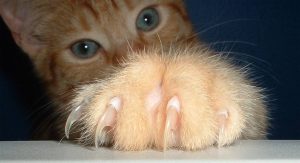Abys Cat Adoption Process and Checklist Part 3
Welcome your cat into its new home!
Have your cat vaccinated, neutered or spayed, and microchipped
If you adopt from a shelter, often these cats will already have this done, or it will be necessary for you to get it done once they reach a certain age. Your cat will be vaccinated against feline distemper and rabies, but there are other vaccinations that your vet may recommend. If your cat isn’t neutered or spayed, the first examination is a perfect time to set up this very important surgery. Microchipping (implanting a traceable chip just under the skin) is also a great idea if your cat ever is lost.
- It isn’t cheap providing the best health care for your cat, but emergency treatment for preventable diseases or conditions is much more expensive. Getting pet insurance helps reduces costs too.
Provide a litter box for the cat
Take a plastic litter box and fill this indoor “restroom” with clean kitty litter. Set the litter box in a quiet area of your house where your cat can easily get to it. When you bring the cat home, show her where the litter box is so she knows where her restroom is located.
- You might put the litter box in a quiet hallway or second bathroom.
Litter train your kitten
While adult cats will already know what to do, you’ll need to train your kitten on how to use the litter box. Training a kitten is pretty easy. Have the box located in an easily accessible spot and set the kitten in it. She will usually use it then and as long as she’s shown it a couple of times she’ll get the idea. Make sure the box isn’t too high. This way, she can get into it easily.
- Be sure to clean the box daily and change the litter every week. This will keep the box fresh. If you let your cat outside, you may often find that they will go to the toilet outside, which means you won’t have to clean out the box as often (or possibly even have one at all).
Offer food and water
Set out a food and water dish that your cat can always get to. Choose as high a quality cat food as you can. This may cost more initially, but food is one of the cheapest ways to keep your cat healthy. If you use dry food, give your cat a can of wet food every once in awhile. Make sure the water dish always has clean, fresh water. Avoid giving milk or cream, since they can cause diarrhea and gas.
- Follow the feeding instructions that come with the cat’s food. Cats can either have food free choice (as long as they don’t overeat) or can be fed three times a day. Keep treats to a minimum, since obesity in cats is a problem that can predispose them to serious diseases like diabetes.
- Feed your kitten a specific kitten food until she turns one, or before if she gains too much weight, or is spayed. Then, transition her to adult cat food over a period of seven to 10 days.
Provide a scratching post and toys
Cats need to scratch for behavioral health. If you don’t offer a scratching post, your cat will scratch wooden furniture and other items. If you find loose claws around your posts, don’t worry, cats lose their claws and replace them with newer sharper claws. If you wish to trim your cat’s claws for the safety of your family or others, ensure you get a vets advice so as to ensure you do not hurt or alarm your cat when doing so. Only trim if necessary, as cats use their claws for many different things, and life is easier for them when they’re sharp, not trimmed.
- Toy mice and other fun toys will help keep your cat entertained and give some exercise.
Decide whether your cat may go outside
If you do let your cat outside, be sure to install a cat flap so she has a way back in. Magnetic cat flaps are recommended as then other cats cannot enter your house. Keep in mind there are a lot of serious hazards outside for cats, but often over time, cats should come to recognise dangers and avoid them eg. Busy roads or regular dog walkers. Cats that go outside may bring you ‘unwanted gifts’ but this is just in their natural hunting instincts. Also, if your cat starts going to the toilet outside, you’re less likely to have to clean out the litter tray as often.
Socialize your cat or kitten
Some cats or kittens with limited human contact might be uncomfortable around people. If your kitten runs, hides, and hisses or spits if she can’t get away, she’s not being aggressive, just fearful. Place the kitten in a cat kennel that’s in a room in the house where there is a lot of human activity, like a kitchen or living room, so she can slowly get used to the TV, radio, and normal everyday human activity.
- Go slow. Don’t force your cat or kitten to interact with you. Gradually let her come to you.
Let the cat or kitten get comfortable with you
Use small bites (less than a fingertip full) of canned kitten food on a spoon tip to entice the kitten to you. In very fearful kittens that do hiss and try to run, wear leather gloves to avoid bite wounds to the hands. Wrap the kitten in a towel with only her head sticking out. This calms the kitten and protects you from scratches.
- Hold the kitten close to your body so your warmth and heartbeat soothe the kitten. Do this for a couple of hours a day to make her comfortable with you. You will know you’ve been successful when the kitten is comfortable enough to purr and fall asleep while you are holding her.
Watch your cat in her new surroundings
Now that you have a new cat in your home, make sure all the family members know how to care for her properly. Teach children not to be too rough, and introduce the cat to other animals so that she won’t be afraid. If you have a kitten, don’t let larger children play too rough with her. Pay attention to your cat’s eating, behavior and bathroom habits so you’ll know if she seems ill.
- Play with your cat often and meet her needs. You’ll find your new pet makes an excellent companion.
Part 3 reprinted from: https://www.wikihow.pet/Adopt-a-Cat


 According to the veterinarian Neil Wolff, declawing is not only unnecessary procedure but it also inhumane. Declawing is an interference with the cat’s nature, and people often decide to do it because of their lack of information and incorrect knowledge.
According to the veterinarian Neil Wolff, declawing is not only unnecessary procedure but it also inhumane. Declawing is an interference with the cat’s nature, and people often decide to do it because of their lack of information and incorrect knowledge.